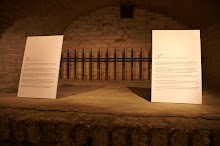Your experts reassured you. “The Aral Sea is nature’s error,” they said. “It should have evaporated long ago. Using its water will be far more advantageous than preserving it.”
You studied its immense expanse between Kazakhstan and Uzbekistan, the fourth largest inland sea in the world, and imagined new desert plantations, and a drained, fertile lakebed. It would easily counterbalance the loss of forty thousand jobs in the fisheries. Planting and exporting the ‘white gold’ of cotton would bring such wealth it would secure the USSR’s transition to socialism and feed the growing nation.
You spent thirty million roubles diverting the two feeder-rivers, and even though the poorly-built canals wasted over fifty percent of their water, you were satisfied.
But as the Aral shrank, a polluted seabed was revealed. Toxic dust storms blew residues from weapons testing, pesticides and fertilisers across the land. Within a decade, human mortality rose fifteen times, and rates of cancer and lung disease rose thirty times. All the Aral’s fish, half its mammals and three-quarters of its birds became extinct. At the same time, the heavily-irrigated plantations raised the water table and turned the desert to salt.
Today the fishing boats lie beached in salt, out of sight of water, testament to the greatest irrigation disaster in history.
skip to main |
skip to sidebar







According to the UNFPA the population of the world increases by 1.2% a year.
That's 235,000 a day.
That's 235,000 a day.
GENE MEME is a blog, art installation and outreach programme about world population.
The GENE MEME art installation took place in the Crypt Gallery in London from 9 June to 20 June 2010.
The GENE MEME art installation took place in the Crypt Gallery in London from 9 June to 20 June 2010.
GENE MEME was supported by a debate asking what should be done about rising population.



Links to posts
- Ancestral Pueblo culture
- Angkor
- Antioch
- Bodmin Moor
- Cahokia
- China’s Great Leap Forward
- Classical Greece
- Easter Island
- Ephesus
- Fatehpur Sikri
- GENE MEME
- Hawaii
- Hispaniola
- Holodomor
- Illinois
- Juana Maria
- Kaskaskia
- Madagascar
- Minimata
- North Korea’s ‘Arduous March’
- Pitcairn Island
- Rabbits in Australia
- Rwanda
- Smallpox
- St Kilda
- St Matthew Island
- Sugar
- The Aleuts
- The American Dustbowl
- The ancient Olmec civilisation
- The Aral Sea
- The burial of Riez
- The collapse of the Nasca
- The decline of Bruges
- The deforestation of Ethiopia
- The extinction of the Moa
- The Florida Everglades
- The Gambier trade triangle
- The great civilisation of Sumer
- The Harappan Culture
- The Irish potato famine
- the last Nicoleňo
- The last passenger pigeon
- The Mayan civilisation
- The pleistocene extinctions
- The Sahel
- The Vikings in Greenland
Search This Blog

